Tobacco control in Macao: a quantitative
analysis on the implementation of WHO
MPOWER measures
Wai-seng Kuok 郭偉誠, Wai-leng Lam 林惠玲, Edmundo PL Lao 劉百球, Mei-kun Lok 陸美娟, Iek-long Lo 羅奕龍
HK Pract 2023;45:45-50
Summary
Objective:
To quantify the implementation of MPOWER
measures in Macao after a decade of legislation and to
compare current MPOWER performance with countries
in Western Pacific.
Design:
Retrospective descriptive study.
Subjects:
The status of tobacco control and policy in
Macao.
Main outcome Measures:
The changes of MPOWER
scores and prevalence of tobacco use in Macao were
studied.
Results:
The MPOWER scores reflected a great
progress from 18 to 34 in the 10 years after legislation.
The prevalence of tobacco and related products use
in population >=15 years of age, from 2011 to 2022,
has declined from 16.9% to 11.1%. The prevalence of
tobacco use in teenage population between 13-15 years
of age, from 2010 to 2021, has declined from 9.5% to
3.8%. For the MPOWER score, Macao ranks on the
front position in Western Pacific for tobacco control.
Conclusions:
After ten years’ implementation of the
MPOWER measures and legislation, Macao has
achieved a greater improvement with her tobacco control, which compares favourably with other Western
Pacific countries. Macao has reached the target for
reducing tobacco use as suggested by the World
Health Organization (WHO) and the prevalence of
tobacco use in Macao remains low.
Keywords:
Tobacco control; WHO MPOWER measures;
Legislation
摘要
目的:
以量化方式探討澳門在訂立控煙法十年後MPOWER
控煙措施的執行,並與目前西太平洋地區作比較。
設計:
回顧性描述性研究。
對象:
澳門的控煙政策現狀。
主要結果測量:
研究了澳門的MPOWER評分及煙草使用率
的改變。
研究結果:
澳門在立法10年後,MPOWER評分從18上升到
34,反映了控煙措施的明顯改善。從2011年到2022年,澳
門15歲以上人口的煙草及相關產品使用率由16.9%下降至
11.1%。從2010年到2021年,13-15歲青少年人口的煙草使用
率從9.5%下降到3.8%。根據MPOWER評分,澳門在控煙執
行方面位居西太平洋地區前列。
結論:
經過十年的MPOWER措施執行和立法,澳門在控
煙方面取得了很大進步,與其他西太平洋國家地區相比毫
不遜色。澳門已達到世界衛生組織建議減少煙草使用的目
標,且目前澳門的煙草使用率仍處於低水平。
關鍵詞:
煙草控制,世界衛生組織 MPOWER 措施,立法
Introduction
Tobacco use is a worldwide public health issue.
According to the WHO, in 2020, 22.3% of the global
population used tobacco. Tobacco is the single largest
preventable cause of death worldwide. There are more
than 8 million deaths a year related to tobacco use,
including around 1.2 million deaths from exposure to second-hand smoking.1 The World Health Organization
Framework Convention on Tobacco Control (WHO
FCTC) is an international agreement that came into
force in response to the global tobacco epidemic.2 The
treaty entered into force on 27th February 2005. In
2008, in order to assist the implementation of the WHO
FCTC in party countries, WHO introduced a package
of 6 measures under the acronym of “MPOWER”
to reduce tobacco use: (M) monitor tobacco use and
prevention policies, (P) protect people from tobacco
smoke, (O) offering help to quit tobacco use, (W) warn
about the dangers of tobacco, (E) enforce bans on
tobacco advertising, promotion and sponsorship, and
(R) raise taxes on tobacco.3 These measures include a
set of policies with proven effectiveness in reducing
smoking and to provide guidelines for tobacco control
in numerous countries and regions.4
China became a party country of the WHO
Framework Convention on Tobacco Control on 9th
January 2006. Macao Special Administrative Region,
as a part of China, is bound by China’s ratification of
the treaty. To consistently implement the FCTC and to
effectively control the tobacco consumption, Macao
put into law “The Regime of Tobacco Prevention and
Control” in 2011 and has been in force since 1st January
2012. There are amendments of law in 2017 so as to
perfect the tobacco control policies and came into force
since 1st January 2018.
Several scoring systems have been developed to
monitor the implementation of MPOWER strategy and
to evaluate the effectiveness of tobacco control policies.
The first such assessment was conducted by Joossens et
al. in European countries in 2006. Then Heydari et al.
designed the MPOWER scoring system and conducted
in Eastern Mediterranean countries in 2012 based on
2011 WHO MPOWER report.5 The objective of this
study is to quantify the implementation of MPOWER
tobacco control policies on the prevalence of tobacco
use in Macao after a decade of legislation and to
compare the current MPOWER implementation with
other nearby countries and regions in Western Pacific.
Methods
The study was conducted to quantify the
implementation of MPOWER measures over the ten
years’ period from 2011 to 2021 in Macao using the
MPOWER score.5 Information was collected from Tobacco Prevention and Control Office of Macao for the
year 2011 and 2021, representing data before and after
legislation. The assessment was based on the checklist
designed by Heydari et al. and the international tobacco
control specialists in their study on tobacco control.5
This MPOWER scoring checklist was adopted by WHO
to quantify MPOWER implementation.
The MPOWER scoring checklist includes 10
questions. There are 7 questions with 5 options scoring
from 0 to 4 points, and 3 questions scoring with 4
options scoring from 0 to 3 points. Each point, for
which data was not available, would be scored as 0. The
total possible score was 37 (7x4 + 3x3). The checklist,
together with the scoring and scale, is shown in Table 1.5
The data related to the prevalence of tobacco use
and the current MPOWER implementation in Macao
was collected from Tobacco Prevention and Control
Office of Macau. The data for the current MPOWER
implementation in countries of Western Pacific was
collected from WHO report on the global tobacco
epidemic, 2021.6
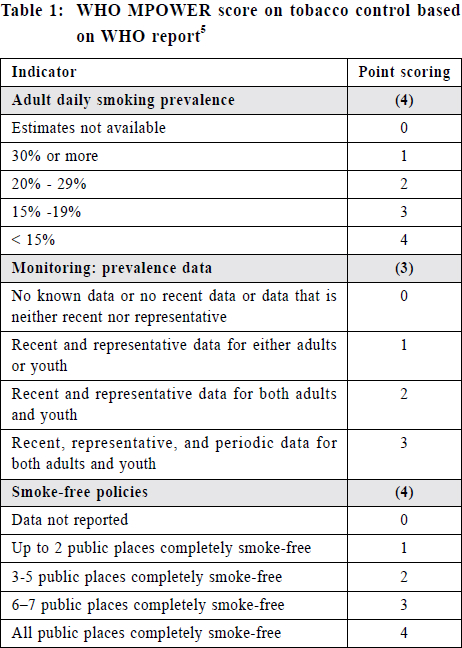

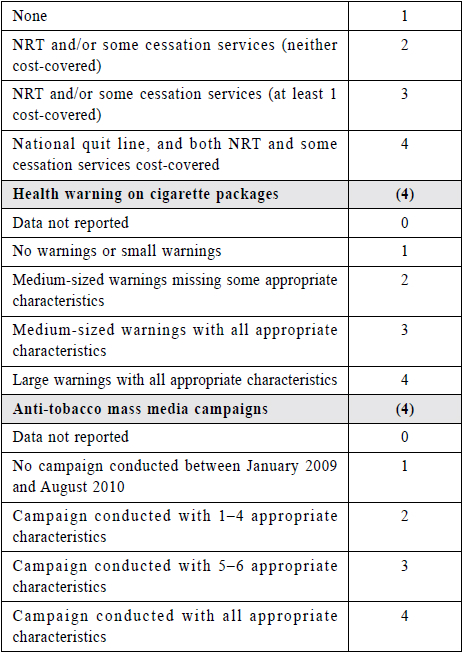
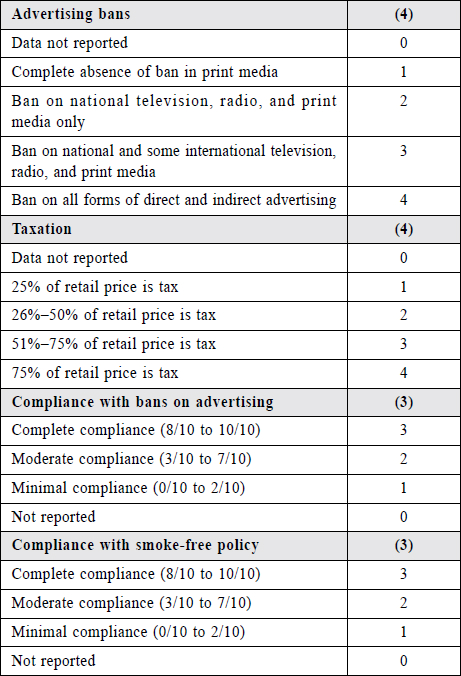
Results
Macao has adopted the MPOWER measures and
shown continuous progress. The MPOWER scores
reflected a great progress from 18 to 34 in the 10
years after legislation (Table 2). Overall, the current
progress in the MPOWER implementation contributed
to the prevalence decline in smoking. The prevalence
of tobacco and related products use in population >=15
years of age in Macao, according to data from Tobacco
Prevention and Control Office from 2011 to 2022, has
declined from 16.9% to 11.1% (in male from 31.4% to
21.5%, in female from 3.8% to 2.2%), which remains
on a low prevalence. The prevalence of tobacco use
in teenage population between 13-15 years of age in
Macao, from 2010 to 2021, has declined from 9.5%
to 3.8% (in male from 8.2% to 3.6%, in female from
10.9% to 4%). These rates demonstrate the success of
tobacco control policies in Macao (Table 3).
The countries and regions are ranked by the total
MPOWER score, and the scores are obtained for each
indicator for each activity. Macao ranks on the front
position in Western Pacific for tobacco control and is
on the second position after New Zealand (Table 5).
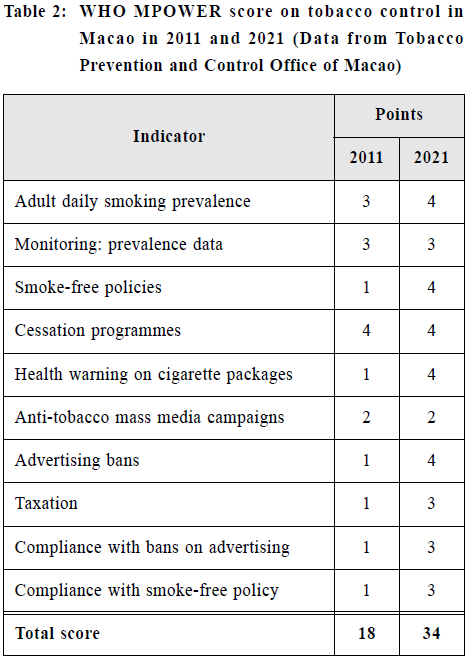
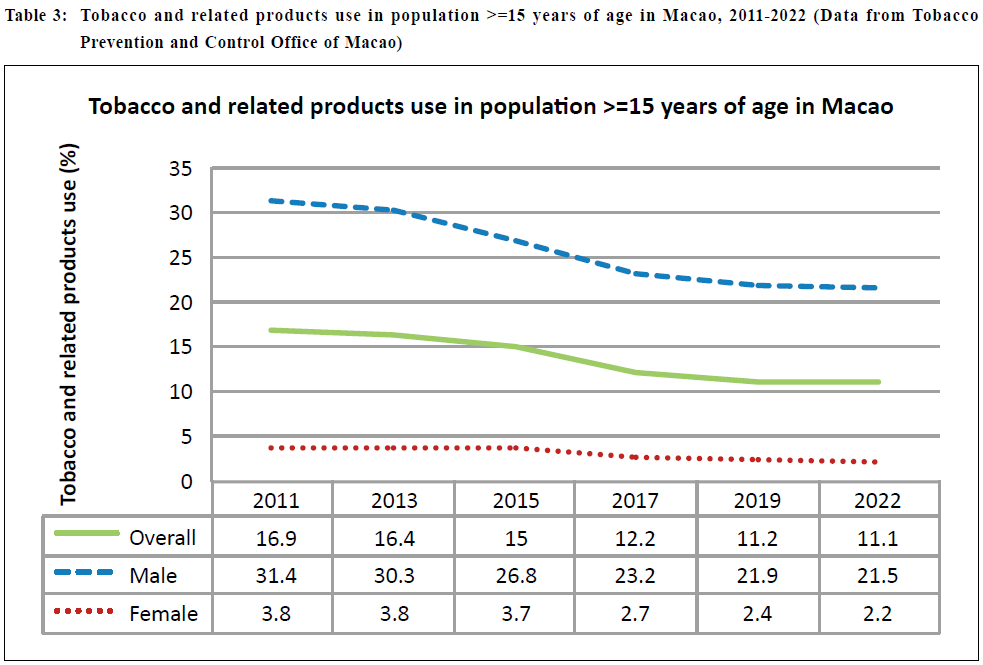
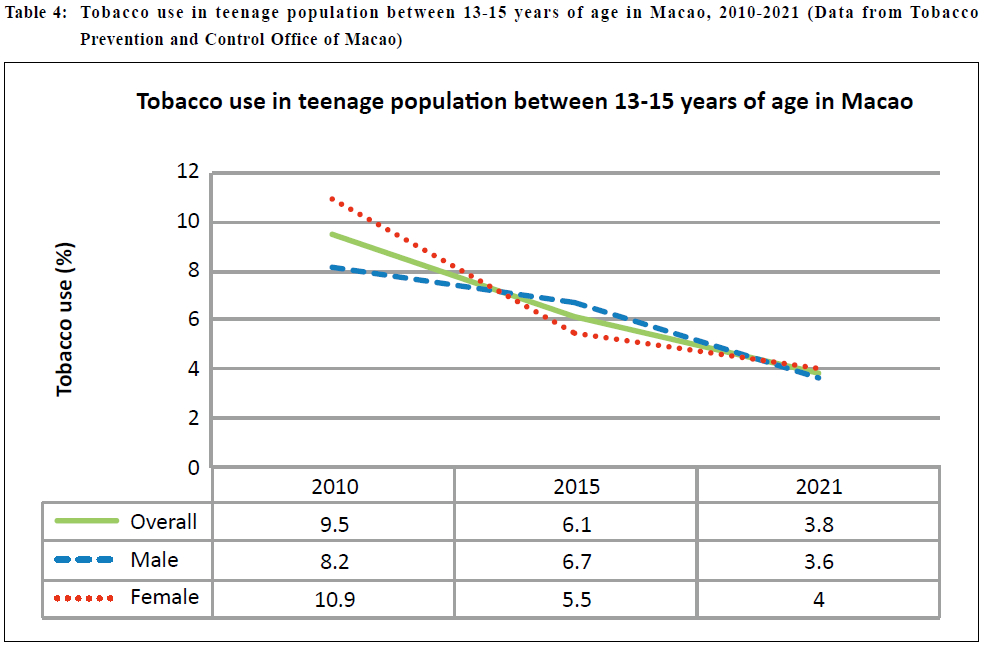
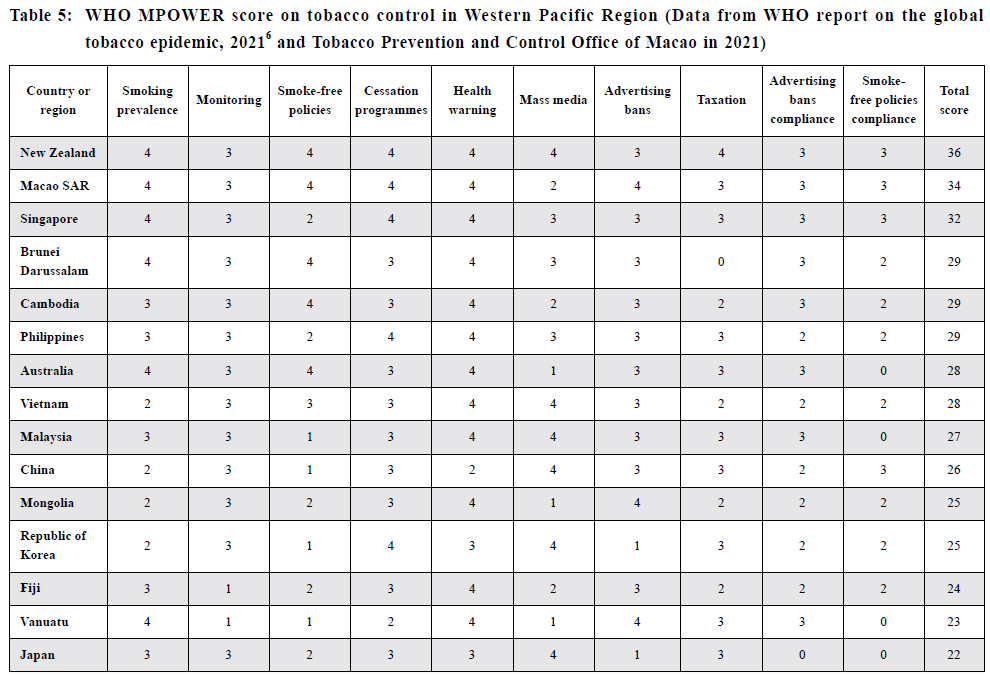
Discussion
This study showed that after a decade of legislation
and implementation of the MPOWER measures between
2011 and 2021, the tobacco control policies and
effectiveness in Macao compare favourably with other
Western Pacific countries or regions. As compared to
2011, the tobacco control status in 2021 has improved
by 16 points of MPOWER score. Individual indicators
showed great improvement in the aspect of smokefree
policies, health warning on cigarette packages,
advertising bans and taxation.
Since the legislation on 1st January 2012, most
of the indoor public places in Macao were prohibited
from smoking, including the medical institutions,
educational institutions, public institutions, indoor
workplaces, restaurants, sports facilities, lifts, elevators,
pedestrian bridges, and pedestrian tunnels, etc. The no
smoking areas were then further extended to casinos,
entertainment venues, parks, garden, bus station and
taxi station. From 1st January 2019, except for the
smoking lounges in airport and the designated smoking
rooms in casinos, all indoor public places in Macao are
completely prohibited from smoking.7
The law further strengthens the control over
packaging and labelling of tobacco products. From
1st January 2013, packages of tobacco products must
carry an authorised pictorial health warning, occupying
at least 50% of the two principal display areas.7 This
makes smokers aware of the health hazard of tobacco
and strengthens their determination to stay away from
tobacco. Virtually, all forms of advertising, promotion
and sponsorship of tobacco and e-cigarettes are
explicitly prohibited. Tobacco products are prohibited
from being publicly displayed in general outlets such
as supermarkets, convenience stores and newsstands.
Tobacco products can only be displayed in the stores
specialising in tobacco products.7 A series of restrictions
aimed at reducing the exposure of tobacco products in
society and their potential appeal to young people.
According to WHO, raising tobacco taxes to above
75% of retail price is the most effective and the most
cost-effective tobacco control measures.4 In recent
years, Macao has adjusted several times on tobacco
taxes. There was an increase of 30 times in cigarette
tax from 0.05 Pataca per stick in 2008 to 1.5 Pataca
per stick in 2015. The current cigarette tax in Macau is
about 60% of retail price, approaching the target of 75% as suggested by WHO, but there is still considerable
room for improvement.7
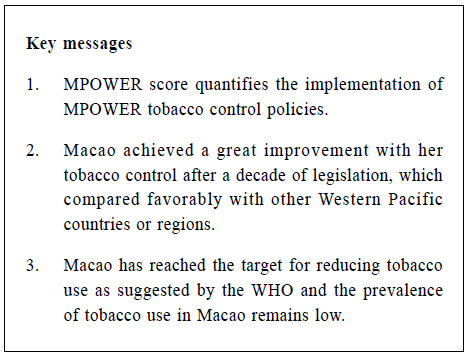
Anti-tobacco mass media campaigns are an
essential component of a comprehensive tobacco control
programme. There is strong evidence that a welldesigned
and hard-biting campaign can reduce tobacco
use, increase quit attempts, and reduce exposure to
second-hand smoke.8,9 More efforts are still needed for
Macao in this regard. Comprehensiveness and targeting
are key elements of effective mass media campaigns.
The messages of smoking cessation are most effective
in environment aiming to make smoking less socially
acceptable. The media should have a broad range which
includes television, radio, print, outdoor billboards,
online advertising, and transit advertising to reach more
people. The messages should be continually and frequent
enough to build awareness and change. Campaign tends
to be more successful when targeting smokers more
broadly rather than specifically.10 In the future, efforts
should be spent more on media publicity with a broader
range of coverage, especially via the mainstream
media such as the internet and social media, and
regular performance review should also be conducted.
The prevalence of tobacco and related products use
in population >=15 years of age in Macao has declined
by 34.3% in a decade since the legislation, from 16.9%
in 2011 to 11.1% in 2022. Macao has reached the target
for reducing tobacco use as suggested by the WHO
Global Action Plan for the Prevention and Control of
Non-communicable Diseases 2013-2020 for reducing the
global prevalence of tobacco use (smoked and smokeless
tobacco) by 30% by the year 2025 relative to 2010.11 The
prevalence of tobacco use in teenage population between
13-15 years of age has declined by 60% from 9.5% in
2010 to 3.8% in 2021. All these data demonstrated the
success of tobacco control policies in Macao.
Limitation
This study does not analyse the improvement of
MPOWER implementation and the decline of smoking
prevalence on the impact of health or morbidity
and mortality of smoking related diseases, such as
cardiovascular disease or lung cancer.
Conclusion
Reviewing the ten years after the implementation
of the MPOWER measures and legislation, Macao has
great improvement on tobacco control policies and
effectiveness, which compare favourably with other
Western Pacific countries or regions. But there is room
for improvement, especially in regard of tobacco taxes
and mass media campaigns. Macao has reached the target
for reducing tobacco use as suggested by the WHO and
the prevalence of tobacco use in Macao remains low.
Acknowledgement
The authors gratefully thank the supervisor, related
doctors and staff of Tobacco Prevention and Control
Office of Macao for providing the necessary data and
support in this research.
References
-
Global Burden of Disease [database]. Washington, DC: Institute of Health
Metrics; 2019. Accessed 2021 July 1.
-
The WHO framework convention on tobacco control - An accelerator for
sustainable development. United Nations Development Programme; 2017
May 30.
-
MPOWER: Six policies to reverse the tobacco epidemic. World Health
Organization; 2008 Dec 29.
-
WHO report on the global tobacco epidemic, 2015: raising taxes on tobacco.
Geneva: World Health Organization; 2015.
-
Heydari G, Flischi T, Algouhmani H, et al. WHO MPOWER tobacco control
scores in the Eastern Mediterranean countries based on the 2011 report.
Eastern Mediterranean Health Journal. 2013; 19(4):314-319.
-
WHO report on the global tobacco epidemic, 2021: Addressing new and
emerging products. Geneva: World Health Organization; 2021.
-
“Smoking prevention and control system” follow-up and evaluation report
2018 –2020. Macao SAR: Health Bureau of Macao; 2021 Feb.
-
The Role of the Media in Promoting and Reducing Tobacco Use. Tobacco
Control Monograph No. 19. Bethesda, MD: U.S. Department of Health and
Human Services, National Institutes of Health, National Cancer Institute.
NIH Pub. No. 07-6242, June 2008.
-
Durkin S, Brennan E, Wakefield M. Mass media campaigns to promote
smoking cessation among adults: an integrative review. Tobacco Control;
2012;21:127–138.
-
Schar Elizabeth, Karen K Gutierrez. Smoking cessation media campaigns
from around the world - Recommendations from lessons learned.
Copenhagen: World Health Organization Regional Office for Europe; 2001
Nov.
-
Global action plan for the prevention and control of non-communicable
diseases 2013–2020. Geneva: World Health Organization; 2013.
Wai-seng Kuok,
Fellow of Macao Academy of Medicine (Family Medicine)
Family Physician,
Ilha Verde Health Centre, Macao
Wai-leng Lam,
MBBS (JNU)
Resident,
Department of Clinical Pathology, Conde S. Januário Hospital, Macao
Edmundo PL Lao,
Fellow of Macao Academy of Medicine (Cardiology)
Specialist in Cardiology,
Department of Cardiology, Conde S. Januário Hospital, Macao
Director of editorial board,
Macao Medical Journal
Mei-kun Lok,
Fellow of Macao Academy of Medicine (Family Medicine)
Chief of Service, Consultant Family Physician,
Ilha Verde Health Centre, Macao
Iek-long Lo,
Fellow of Macao Academy of Medicine (Pneumology)
Director of Macao Health Bureau, Consultant Pneumologist
Correspondence to:
Dr. Iek-long Lo, Director of Macao Health Bureau, Macao, China
E-mail: alvislo@ssm.gov.mo
|
